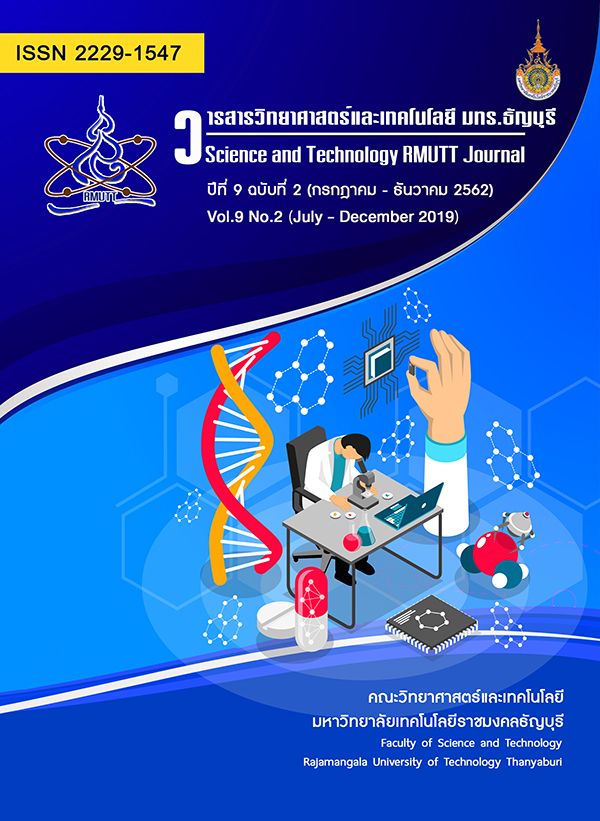Metal and dyes removal from waste water using lotus leaves adsorbent
Main Article Content
Abstract
This research aim to study metal and dyes removal from waste water using lotus leaves adsorbent. The parameters that effect on adsorption efficiency including initial pH solution, initial concentration of metal and dyes in waste water, weight of adsorbent and adsorption time were investigated. From the results, the optimum condition for crystal violet dyes removal was initial pH of solution at 8, 1400 milligrams per liter of crystal violet in waste water, 0.05 grams of adsorbent, adsorption time of 30 minutes. With optimum condition, the adsorption efficiency of crystal violet dyes was 214 milligrams dye per gram adsorbent. In a part of Pb removal, the condition that was maximum value of Pb removal from waste water was initial pH of solution at 5, 1800 milligrams per liter of Pb in wastewater, 0.2 grams of adsorbent, adsorption time of 30 minutes. The Pb removal efficiency with lotus leaves adsorbent was 76 milligrams per gram of adsorbent. The results shown the high value of metal adsorption efficiency and dyes adsorption efficiency indicated that lotus leaves adsorbent can be used as new adsorbent for Pb removal and crystal violet removal from waste water. Additionally, the adsorption isotherms that consist of Langmuir isotherm and Freundlich isotherm were conducted. The results shown that the trends of isotherm graph from this research was well agreement with Freundlich isotherm. The FT-IR spectra of adsorbents (before and after dyes adsorption) were different peaks at 1577, 1355, 1170 and 728 cm-1 that can be explain to the position of binding site between crystal violet dyes and adsorbent.
Article Details
References
K. A. Adegoke and O. S. Bello, Water Resources and Industry 2015, 12, 8-24.
A. Demirbas, Journal of Hazardous Materials 2008, 157, 220-229.
A. Gundogdu, D. Ozdes, C. Duran, V. N. Bulut, M. Soylak and H. B. Senturk, Chemical Engineering Journal 2009, 153, 62-69.
Y. Wang, F. Z. Wang, T. Wan, S. L. Cheng, G. Q. Xu, R. Cao and M. Gao, Journal of Wuhan University of Technology-Materials Science Edition 2013, 28, 650-657.
G. Islamuddin, M. A. Khalid and S. A. Ahmad, Ukrainian Journal of Ecology 2019, 9, 68-75.
H.-Y. Choi, K.-h. Jung and H.-s. Shin, Food Sci Biotechnol 2009, 18, 5.
M. A. M. Salleh, D. K. Mahmoud, W. A. W. A. Karim and A. Idris, Desalination 2011, 280, 1-13.
R. Ahmad, Journal of Hazardous Materials 2009, 171, 767-773.
S. Jain and R. V. Jayaram, Desalination 2010, 250, 921-927.
S. Chakraborty, S. Chowdhury and P. Das Saha, Carbohydrate Polymers 2011, 86, 1533-1541.
A. Saeed, M. Sharif and M. Iqbal, Journal of Hazardous Materials 2010, 179, 564-572.
O. Aksakal and H. Ucun, J Hazard Mater 2010, 181, 666-672.
P. Saha, S. Chowdhury, S. Gupta and I. Kumar, Chemical Engineering Journal 2010, 165, 874-882.
T. Ogata and Y. Nakano, Water Research 2005, 39, 4281-4286.
Y. H. Lin, X. B. He, G. M. Han, Q. J. Tian and W. Y. Hu, Journal of Environmental Sciences-China 2011, 23, 2055-2062.
H. Ucun, Y. K. Bayhan, Y. Kaya, A. Cakici and O. F. Algur, Desalination 2003, 154, 233-238.
R. Ayyappan, A. C. Sophia, K. Swaminathan and S. Sandhya, Process Biochemistry 2005, 40, 1293-1299.


